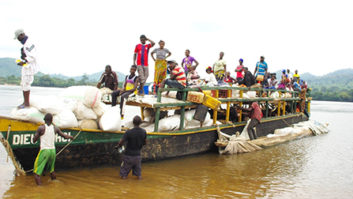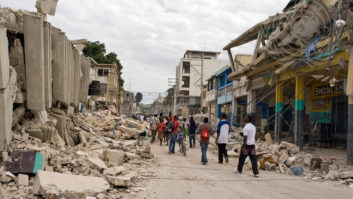
RNW contributor Marco Keehnen works with a rapid response set in Padang, Indonesia.
PORT-AU-PRINCE, Haiti — Dutch foreign-service broadcaster Radio Nederland Wereldomroep was asked to ship a mobile radio station to Haiti to help restore communications and information-supply after the Jan. 13 earthquake that counted several radio stations among its victims.
RNW already established a solid reputation when it comes to providing temporary broadcast facilities. In 2004, the Indian Ocean tsunami washed over part of Indonesia, causing the loss of several of RNW partner stations and staffers. To help those stations and listeners in the tsunami zone, RNW decided to develop mobile radio stations stuffed in containers, “a radio in a box,” and to ship them to Indonesia.
Back on the air
“That really worked out and helped the local Indonesian partner back on FM.” said Marc Brouwer, technical coordinator at RNW. “But the transshipment of a container takes at least four weeks, and sometimes this is just too long, so we also thought of developing a rapid response set.”
RNW shipped three containerized stations to Indonesia, but forged ahead with the development of a compact and easy-to-operate radio set. In August 2009, RNW engineers had designed two mobile radio studio sets.
“They were first used last October, when an earthquake rocked Padang, the capital of West Sumatra (Indonesia), on 30 September. The sets did a great job,” continued Brouwer.
In case of the Haitian earthquake, RNW worked together with the Commonwealth Broadcasting Association working to deploy the Dutch mobile radio solutions.
“We have a very good working relationship with CBA, the BBC and Radio Canada International, and they knew we had the rapid response sets ready,” said Brouwer. “CBA has a partner network in Haiti, and they heard some 20 radio stations were damaged or destroyed due to the earthquake. Let’s face it: public or commercial radio, there’s just no money to re-build them, so sending out the rapid response sets is a first step. Two “radio in a box” containers are standing by for a second phase.”

Modern needs
The rapid response sets have evolved since their deployment in Padang; they have been tweaked to suit the modern needs of radio journalists.
Each set consists of what Brouwer calls “back-to-basics radio”: two microphones, a Marantz PMD620 flash memory-based recorder, a Denon CD player, a laptop computer for recording and editing audio material, Berhinger mixer and a 100 W RVR transmitter, all housed in a flight case. Each set comes with a separate, fuel-driven mains power supply.
A first rapid response set was shipped to Haiti at the end of January and arrived in Santo Domingo, Dominican Republic, where it was in customs clearance at press time in mid February.
“The CBA will take official delivery of the radio set and will investigate whether there’s sufficient skilled radio personnel left in Haiti to operate the mobile studio,” Brouwer said.
Brouwer explained access to information is part of RNW’s mission statement, and supplying material for broadcast use fits that goal.










